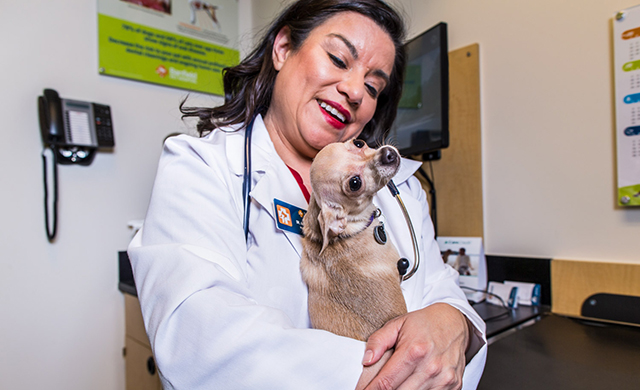
You Brush Your Teeth Daily, but What About Your Pet’s?
06/21/2018 06:00AM | 8953 viewsYes, just like your mother taught you. Good health starts with brushing your teeth – and the same is true for your dogs and cats.
Banfield veterinarians Dr. Mary Guerra from Dallas and Dr. Maria Ramirez-Gorton from Newport News, VA, agree it’s important to prioritize dental hygiene for your pets.
“Pets can’t tell us if their mouth hurts,” said Dr. Guerra. “If there’s anything I can add to a pet’s quality of life, it’s good oral care.”
According to Dr. Guerra, people don’t usually think about their pet’s mouth when considering their health and wellbeing – and even when they do, it can be hard for pet owners to know what to look for.
“You’d be amazed at the things we have found – broken teeth, rotten teeth,” said Dr. Guerra. “Dogs will chew on rocks and wood, which can crack a tooth. If you’re not regularly checking their teeth and partnering with your veterinarian on your pet’s oral hygiene, you may not notice something’s wrong until your pet stops eating. But by that time, he or she may have been in pain for several months.”
Dental disease is the most common disease in dogs and cats, affecting 76 percent of dogs and 68 percent of cats, according to Banfield’s State of Pet Health Report. Dental disease includes any health issue affecting the mouth, including inflammation, tartar, gingivitis and periodontal disease, among others.Smaller breed dogs, including Dachshunds, Yorkshire Terriers, Shih Tzu’s, and Maltese’s, have a higher prevalence of dental disease.
Left untreated, dental disease can lead to infection, tooth loss, bone damage and oral pain – and is associated with serious, life-threatening conditions in pets, such as cardiac disease and renal disease. Even when not life-threatening, the pain and discomfort of dental disease can negatively impact pets and significantly reduce their quality of life. As such, the benefits of preventing and treating dental disease before it becomes serious is an essential part of pet ownership.
Quality of life starts in the mouth.
Preventive care is about quality of life for a pet, and veterinary dental care is an essential component of a pet's preventive healthcare plan– and you definitely don’t want to wait until something is wrong. For one thing, by waiting so long the situation probably will be more expensive to address. Even more important, we never want our furry friends to be in pain or discomfort.
Dr. Ramirez-Gorton has seen case after case of clients thinking their dog or cat was just getting older and sleepier, but the real cause was a lurking dental issue.
“People think their pets are fine because they’re eating and drinking, but dogs are pretty stoic,” said Dr. Ramirez-Gorton. “They will live with pain. After we take care of the issues, you see the impact. I’ve heard many people say ‘wow, it’s like I have a puppy again!’”
That’s why Dr. Guerra and Dr. Ramirez-Gorton both recommend:
- Dental exams twice a year
- Dental cleanings once a year
- Brushing daily
“Once-in-a-lifetime dental exams used to be the way people did it,” said Dr. Ramirez-Gorton. “Pets would lose many teeth. Now that we’re recommending annual cleanings from a young age, we’re preventing periodontal disease and discomfort.”
The AAHA Dental Care Guidelines for Dogs and Cats recommends yearly dental cleanings for dogs and cats. Banfield is committed to making preventive care accessible and affordable for pet owners through its Optimum Wellness Plans, which include annual dental cleanings for a predictable monthly price.
In addition to the exams and cleanings, here’s what you can do at home.
Brush your pet’s teeth daily.For those of you with pets that won’t sit still for a full brushing, Dr. Guerra suggests focusing on the upper teeth one day, the bottom teeth the next.
Use pet-specific toothpaste.Partner with your veterinarian to determine the best toothpaste for your pet. And never use human toothpaste on your pets – our toothpaste isn’t made to be swallowed, theirs is.
Keep an eye out for behaviors that could indicate dental trouble:
- Bad breath
- Difficulty chewing or grasping food
- Chewing only on one side of mouth
- Decreased appetite
- Increased salivation
- Changes in food preferences
Examine your pet’s teeth at home. Flip your pet’s lip and look for gums that are red or swollen and teeth that are yellow, brown, loose or missing. If you spot any of these things, it’s time for a trip to the veterinarian.
Give your pet dental chews and treats.Ask your veterinarian for recommendations on dog and cat treats that will support your pet’s dental hygiene plan. Just as with people, a dental treat or chew for your pet should never replace brushing or annual cleanings. Also consider food specially formulated to address dental disease – your veterinarian can recommend the best option for your pet.
“A pet’s oral health tends to go hand in hand with its overall physical health,” said Dr. Guerra.
For more information on dental disease, talk to your veterinarian, and visit StateofPetHealth.com. To find a Banfield Pet Hospital near you, visit www.banfield.com.











Post your Comment
Please login or sign up to comment
Comments